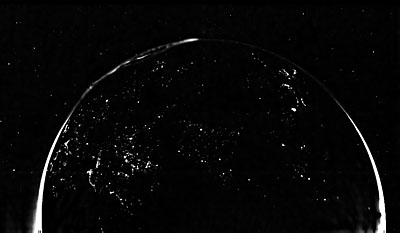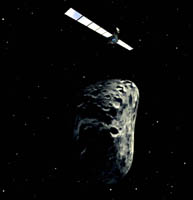[/caption]
Since waking up in early July from a brief hibernation, the Rosetta space probe has passed yet another milestone on the long journey to its rendezvous with the comet 67/P Churyumov-Gerasimenko in 2014: it has begun tracking the asteroid (2867) Steins. The spacecraft will perform a close flyby of the asteroid on September 5th, 2008, and will spend the next month taking images and science data.
Steins will remain a dot in the sky to the probe for quite a while, but these preliminary images will allow the spacecraft to get a better handle on the orbit of the asteroid, as well as its rotational period. Using the Optical, Spectroscopic, and Infrared Remote Imaging System (OSIRIS) camera, it will image the asteroid twice a week until the 25th of August, and then will take daily images until the planned flyby on September 5th. Rosetta will pass within 800 km (500 miles) of the asteroid, imaging and taking data at the relatively slow speed of 8.6 km/second (5.3 miles/second).
The trajectory of Steins has already been established from ground-based observations, but the imaging leading up to the flyby will help to optimize the trajectory of the spacecraft. The location of the asteroid is known to within 100 km presently, but the work Rosetta will be doing will narrow that down to 2 km.
“As Rosetta’s distance from Steins decreases, the precision of the measurements for Steins’ orbit will increase even further, allowing us the best possible trajectory corrections later on before closest approach, especially in early September,” said Sylvain Lodiot, from the Rosetta Flight Control Team at the European Space Operations Centre.
During the flyby of Steins, Rosetta will study the physical and chemical properties of the asteroid. It will also provide scientists with a detailed look into the kinematic properties (how fast it is spinning), and how the asteroid interacts with the solar wind. Being so close to Stein will give Rosetta a chance to analyze any satellites of the asteroid, as well as the gas and dust in the near vicinity.
Rosetta launched in March 2004, and is taking a roundabout way to get to the final destination of comet 67/P Churyumov-Gerasimenko. It has passed by the Earth twice – once in March 2005, and once again in February 2007 – with another flyby scheduled for November 2009. While doing the most recent flyby it took this spectacular image of the Earth at night with the OSIRIS camera. The lighted regions are populated areas on continents in the Northern Hemisphere.
Earth isn’t the only celestial body that the spacecraft has visited, though. It passed within 1,000 km (620 miles) of Mars in Februrary 2007, and will perform a flyby of the asteroid 21 Lutetia in 2010. This game of planetary billiards is meant to adjust the trajectory of the spacecraft, and the imaging done on the Earth, Mars and the asteroids helps the science team work out all of the bugs in the host of science instruments on board.
Once it has arrived at 67/P Churyumov-Gerasimenko, it will deploy a lander, named Philae, which will drill into the comet to study for the first time ever the compositional nature of a comet. Rosetta will orbit the comet, following it around the Sun.
If you want to keep tabs on the progress of the Rosetta mission, the ESA has a flash animation tool that allows you to zoom in on any part of the mission.
Source: ESA Press Release


Fascinating, in my youth no one could have remotely imagined the extent of study going on right now in the solar system. And with asteroids and comets no less!
Kudos to the science and organization that can make this happen. The asteroid bodies of the solar system hold both promise and menace to our planet. Missions like these give us the means to study these objects for both the enrichment of our spieces and the avoidance of disaster.